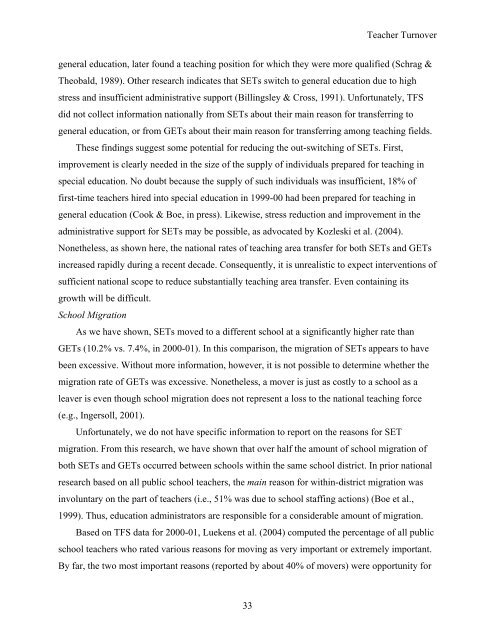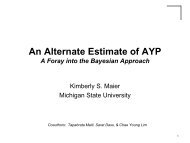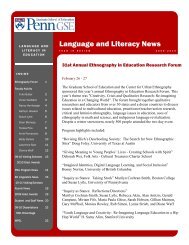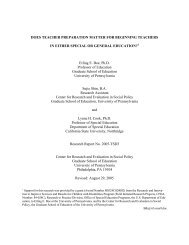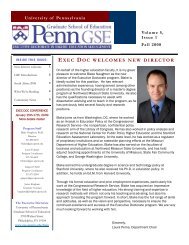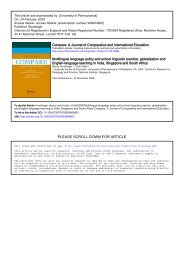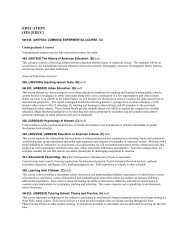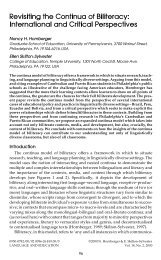Teacher turnover in special and general education: attrition
Teacher turnover in special and general education: attrition
Teacher turnover in special and general education: attrition
You also want an ePaper? Increase the reach of your titles
YUMPU automatically turns print PDFs into web optimized ePapers that Google loves.
<strong>Teacher</strong> Turnover<br />
<strong>general</strong> <strong>education</strong>, later found a teach<strong>in</strong>g position for which they were more qualified (Schrag &<br />
Theobald, 1989). Other research <strong>in</strong>dicates that SETs switch to <strong>general</strong> <strong>education</strong> due to high<br />
stress <strong>and</strong> <strong>in</strong>sufficient adm<strong>in</strong>istrative support (Bill<strong>in</strong>gsley & Cross, 1991). Unfortunately, TFS<br />
did not collect <strong>in</strong>formation nationally from SETs about their ma<strong>in</strong> reason for transferr<strong>in</strong>g to<br />
<strong>general</strong> <strong>education</strong>, or from GETs about their ma<strong>in</strong> reason for transferr<strong>in</strong>g among teach<strong>in</strong>g fields.<br />
These f<strong>in</strong>d<strong>in</strong>gs suggest some potential for reduc<strong>in</strong>g the out-switch<strong>in</strong>g of SETs. First,<br />
improvement is clearly needed <strong>in</strong> the size of the supply of <strong>in</strong>dividuals prepared for teach<strong>in</strong>g <strong>in</strong><br />
<strong>special</strong> <strong>education</strong>. No doubt because the supply of such <strong>in</strong>dividuals was <strong>in</strong>sufficient, 18% of<br />
first-time teachers hired <strong>in</strong>to <strong>special</strong> <strong>education</strong> <strong>in</strong> 1999-00 had been prepared for teach<strong>in</strong>g <strong>in</strong><br />
<strong>general</strong> <strong>education</strong> (Cook & Boe, <strong>in</strong> press). Likewise, stress reduction <strong>and</strong> improvement <strong>in</strong> the<br />
adm<strong>in</strong>istrative support for SETs may be possible, as advocated by Kozleski et al. (2004).<br />
Nonetheless, as shown here, the national rates of teach<strong>in</strong>g area transfer for both SETs <strong>and</strong> GETs<br />
<strong>in</strong>creased rapidly dur<strong>in</strong>g a recent decade. Consequently, it is unrealistic to expect <strong>in</strong>terventions of<br />
sufficient national scope to reduce substantially teach<strong>in</strong>g area transfer. Even conta<strong>in</strong><strong>in</strong>g its<br />
growth will be difficult.<br />
School Migration<br />
As we have shown, SETs moved to a different school at a significantly higher rate than<br />
GETs (10.2% vs. 7.4%, <strong>in</strong> 2000-01). In this comparison, the migration of SETs appears to have<br />
been excessive. Without more <strong>in</strong>formation, however, it is not possible to determ<strong>in</strong>e whether the<br />
migration rate of GETs was excessive. Nonetheless, a mover is just as costly to a school as a<br />
leaver is even though school migration does not represent a loss to the national teach<strong>in</strong>g force<br />
(e.g., Ingersoll, 2001).<br />
Unfortunately, we do not have specific <strong>in</strong>formation to report on the reasons for SET<br />
migration. From this research, we have shown that over half the amount of school migration of<br />
both SETs <strong>and</strong> GETs occurred between schools with<strong>in</strong> the same school district. In prior national<br />
research based on all public school teachers, the ma<strong>in</strong> reason for with<strong>in</strong>-district migration was<br />
<strong>in</strong>voluntary on the part of teachers (i.e., 51% was due to school staff<strong>in</strong>g actions) (Boe et al.,<br />
1999). Thus, <strong>education</strong> adm<strong>in</strong>istrators are responsible for a considerable amount of migration.<br />
Based on TFS data for 2000-01, Luekens et al. (2004) computed the percentage of all public<br />
school teachers who rated various reasons for mov<strong>in</strong>g as very important or extremely important.<br />
By far, the two most important reasons (reported by about 40% of movers) were opportunity for<br />
33


